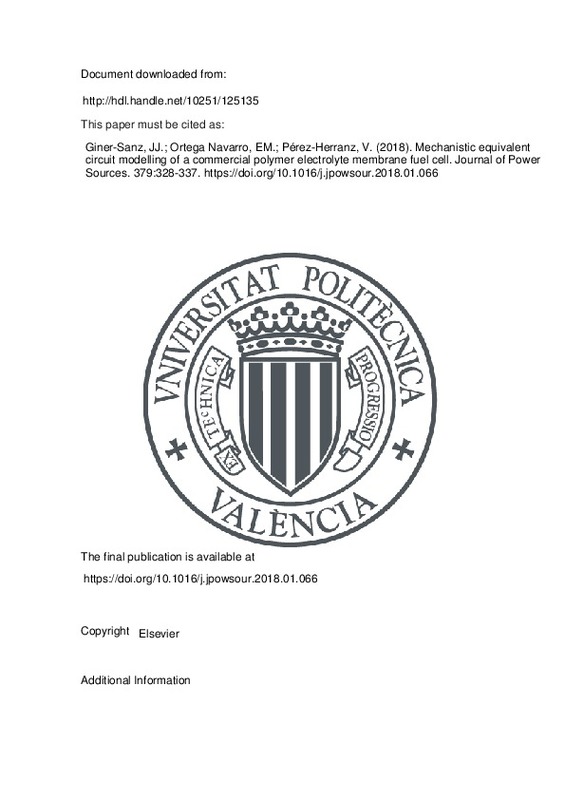JavaScript is disabled for your browser. Some features of this site may not work without it.
Buscar en RiuNet
Listar
Mi cuenta
Estadísticas
Ayuda RiuNet
Admin. UPV
Mechanistic equivalent circuit modelling of a commercial polymer electrolyte membrane fuel cell
Mostrar el registro sencillo del ítem
Ficheros en el ítem
| dc.contributor.author | Giner-Sanz, Juan José
|
es_ES |
| dc.contributor.author | Ortega Navarro, Emma María
|
es_ES |
| dc.contributor.author | Pérez-Herranz, Valentín
|
es_ES |
| dc.date.accessioned | 2019-09-05T20:05:46Z | |
| dc.date.available | 2019-09-05T20:05:46Z | |
| dc.date.issued | 2018 | es_ES |
| dc.identifier.issn | 0378-7753 | es_ES |
| dc.identifier.uri | http://hdl.handle.net/10251/125135 | |
| dc.description.abstract | [EN] Electrochemical impedance spectroscopy (EIS) has been widely used in the fuel cell field since it allows deconvolving the different physic-chemical processes that affect the fuel cell performance. Typically, EIS spectra are modelled using electric equivalent circuits. In this work, EIS spectra of an individual cell of a commercial PEM fuel cell stack were obtained experimentally. The goal was to obtain a mechanistic electric equivalent circuit in order to model the experimental EIS spectra. A mechanistic electric equivalent circuit is a semiempirical modelling technique which is based on obtaining an equivalent circuit that does not only correctly fit the experimental spectra, but which elements have a mechanistic physical meaning. In order to obtain the aforementioned electric equivalent circuit, 12 different models with defined physical meanings were proposed. These equivalent circuits were fitted to the obtained EIS spectra. A 2 step selection process was performed. In the first step, a group of 4 circuits were preselected out of the initial list of 12, based on general fitting indicators as the determination coefficient and the fitted parameter uncertainty. In the second step, one of the 4 preselected circuits was selected on account of the consistency of the fitted parameter values with the physical meaning of each parameter. | es_ES |
| dc.description.sponsorship | The authors are very grateful to the Generalitat Valenciana for its economic support in form of Vali + d grant (Ref: ACIF-2013-268). | es_ES |
| dc.language | Inglés | es_ES |
| dc.publisher | Elsevier | es_ES |
| dc.relation.ispartof | Journal of Power Sources | es_ES |
| dc.rights | Reconocimiento - No comercial - Sin obra derivada (by-nc-nd) | es_ES |
| dc.subject | Electrochemical Impedance Spectroscopy (EIS) | es_ES |
| dc.subject | PEM fuel cell | es_ES |
| dc.subject | Mechanistic electric equivalent circuit | es_ES |
| dc.subject | Low frequency inductive loop | es_ES |
| dc.subject | Semiempirical modelling | es_ES |
| dc.subject.classification | INGENIERIA NUCLEAR | es_ES |
| dc.subject.classification | INGENIERIA QUIMICA | es_ES |
| dc.title | Mechanistic equivalent circuit modelling of a commercial polymer electrolyte membrane fuel cell | es_ES |
| dc.type | Artículo | es_ES |
| dc.identifier.doi | 10.1016/j.jpowsour.2018.01.066 | es_ES |
| dc.relation.projectID | info:eu-repo/grantAgreement/GVA//ACIF%2F2013%2F268/ | es_ES |
| dc.rights.accessRights | Abierto | es_ES |
| dc.contributor.affiliation | Universitat Politècnica de València. Departamento de Ingeniería Química y Nuclear - Departament d'Enginyeria Química i Nuclear | es_ES |
| dc.description.bibliographicCitation | Giner-Sanz, JJ.; Ortega Navarro, EM.; Pérez-Herranz, V. (2018). Mechanistic equivalent circuit modelling of a commercial polymer electrolyte membrane fuel cell. Journal of Power Sources. 379:328-337. https://doi.org/10.1016/j.jpowsour.2018.01.066 | es_ES |
| dc.description.accrualMethod | S | es_ES |
| dc.relation.publisherversion | https://doi.org/10.1016/j.jpowsour.2018.01.066 | es_ES |
| dc.description.upvformatpinicio | 328 | es_ES |
| dc.description.upvformatpfin | 337 | es_ES |
| dc.type.version | info:eu-repo/semantics/publishedVersion | es_ES |
| dc.description.volume | 379 | es_ES |
| dc.relation.pasarela | S\353083 | es_ES |
| dc.contributor.funder | Generalitat Valenciana | es_ES |







![[Cerrado]](/themes/UPV/images/candado.png)

